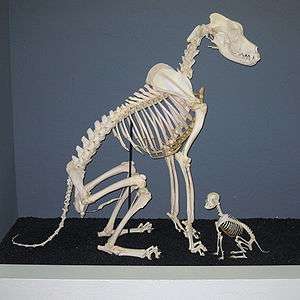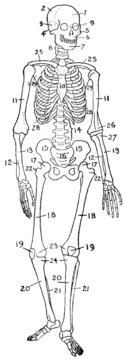Osteology
Osteology, derived from the Greek words osteon .(bone) and logos (knowledge), is the scientific study of bones, practised by osteologists. A subdiscipline of anatomy, anthropology, and paleontology, osteology is a detailed study of the structure of bones, skeletal elements, teeth, microbone morphology, function, disease, pathology, the process of ossification (from cartilaginous molds), and the resistance and hardness of bones (biophysics). A person who examines bones and determines cause of death is a forensic anthropologist. Forensic anthropologists are often used by scientists to help identify age, death, sex, growth, and development of human remains and can be used in a biocultural context. Sexual dimorphism is the difference of size in male and female skeletons. The two bone structures that are used to determine whether a person is male or female are the skull and pelvis. The bones can also be used to reveal the age of the person before they died. At birth the human cranial vault consists of seven separate bones; by age 5 these bones have knitted together at the cranial sutures. At about the age of 30 , the sutures generally begin to fill in with bone and smooth out. Another way to tell the age of bones is by bone osteons under a microscope or look for arthritis indicators on the bones. Younger adults have fewer and larger osteons while older adults have smaller and more osteon fragments, but arthritis will cause noticeable rounder bones. Osteology can determine an individual's race. It is typically grouped into three historical groups: Caucasoid, Mongoloid, and Negroid. But this classification systejm is becoming hard to use with each new generation of people. With this bone is the frame of life and the frame of the "big four of forensic anthropology" (sex, age, race, and stature) can be determined. Osteologists frequently work in the public and private sector as consultants for museums, scientists for research laboratories, scientists for medical investigations and/or for companies producing osteological reproductions in an academic context.
Osteology and osteologists should not be confused with the holistic practice of medicine known as osteopathy and its practitioners, osteopaths.
Methods
A typical analysis will include:
- an inventory of the skeletal elements present
- a dental inventory
- aging data, based upon epiphyseal fusion and dental eruption (for subadults) and deterioration of the pubic symphysis or sternal end of ribs (for adults)
- stature and other metric data
- ancestry
- non-metric traits
- pathology and/or cultural modifications
Applications

Osteological approaches are frequently applied to investigations in disciplines such as vertebrate paleontology, zoology, forensic science, physical anthropology and archaeology, and has a place in research on topics including:
- Ancient warfare
- Activity patterns
- Criminal investigations
- Demography
- Developmental biology
- Diet
- Disease
- Genetics of early populations
- Fossil assemblages
- Health
- Human migration
- Identification of unknown remains
- Physique
- Social inequality
- War crimes
Crossrail Project
A recent endeavor by the city of London to expand their railway system inadvertently uncovered 25 human skeletons at Charterhouse Square in 2013. Although archaeological excavation of the skeletons temporarily halted the further advances in the railway system, they have given way to new, possibly revolutionary discoveries in the field, as well as re-write history.
These 25 skeletal remains, along with many more that were found in further searches, are believed to be from the mass graves dug to bury the millions of victims of the Black Death in the 14th century. Archaeologists and forensic scientists have used osteology to examine the condition of the skeletal remains, to help piece together the reason why the Black Death had such a detrimental effect on the European population. It was discovered that most of the population was in generally poor health, to begin with. Through extensive analysis of the bones, it was discovered that many of the inhabitants of Great Britain were plagued with rickets, anemia, and malnutrition.[1] There has also been frequent evidence that much of the population had traces of broken bones from frequent fighting and hard labor.
This archaeological project has been named the Crossrail Project. Archaeologists will continue to excavate and search for remains to help uncover missing pieces of history. These advances in our understanding of the past will be improved by the study of other skeletons buried in the same area.
See also
- Osteometric points
- Museum of Osteology
- Forensic Anthropology
- Paleontology
- Bone Clones
Notes
- McCoy, Terrence. "Everything you know about the Black Death is wrong". The Washington Post. Retrieved 4 April 2014.
References
- Bass, W. M. 2005. Human Osteology: A Laboratory and Field Manual. 5th Edition. Columbia: Missouri Archaeological Society.
- Buikstra, J. E. and Ubelaker, D. H. (eds.) 1994. Standards for Data Collection from Human Skeletal Remains. Arkansas Archeological Survey Research Series No. 44.
- Cox, M and Mays, S. (eds.) 2000. Human Osteology in Archaeology and Forensic Science. London: Greenwich Medical Media.
- F.F.A. Ijpma, H.J. ten Duis, T.M. van Guilik 2012." A cornerstone of orthopaedic education". Bones & Joint 360, Vol. 1, No. 6
- Ekezie, Jervas, PHD, "Bone, the Frame of Human Classification: The Core of Anthropology". Department of Anatomy, School of Basic Medical Sciences, Federal University of Technology, PMB 1526, Owerri, Nigeria. Volume 2: Issue 1.
External links
| Wikimedia Commons has media related to Osteology. |
